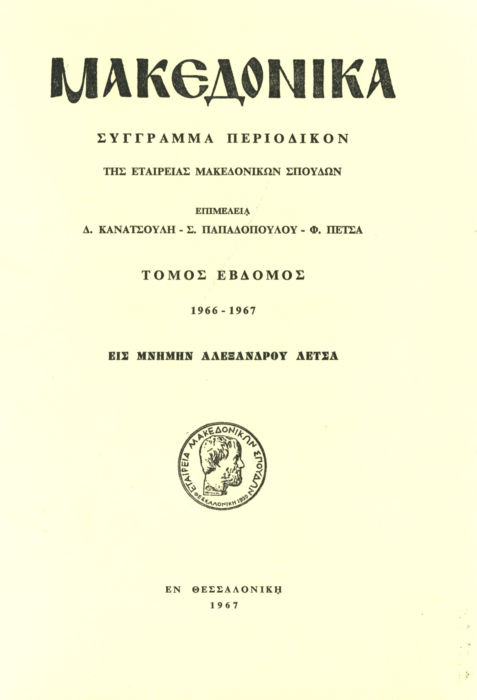Εστί της Πρασιάδος λίμνης σύντομος κάρτα ες την Μακεδονίην (Ηροδ. V, 17)
Abstract
L’auteur fait un examen approfondi du passage d’Hérodote V, 17 et
conclut qu’ Hérodote parle de deux mines dont l’une se trouve entre le lac
Prasias et le mont Dysoron et l’autre c’est le même mont Dysoron. En ce
qui concerne le lac du passage, elle accepte qu’il s’agit du lac de Doirane et
ajoute que Dysoron doit être la chaîne qui s’élève de long le cours d’Axios,
du Hudova jusqu’ à «τό παρά θάλασσαν στεινόν χωρίον» (d’après Hérod.
VII, 123). Elle croit que sous la règne d’Amyntas 1er la partie du sud de cette
chaîne de monts, nommée Paikon, appartenait à la Macédoine, et en ajoutant
d’autres arguments toponymiques et géologiques, conclut que la route «σύντομος
κάρτα» passait à travers le Paikon septentrional.
Article Details
- Come citare
-
Παπαγεωργίου Μ. Γ. (2015). Εστί της Πρασιάδος λίμνης σύντομος κάρτα ες την Μακεδονίην (Ηροδ. V, 17). Μακεδονικά, 10(1), 1–22. https://doi.org/10.12681/makedonika.738
- Fascicolo
- V. 10
- Sezione
- Άρθρα

Questo lavoro è fornito con la licenza Creative Commons Attribuzione - Non commerciale - Condividi allo stesso modo 4.0 Internazionale.
Authors who publish with this journal agree to the following terms:
- Authors retain copyright and grant the journal right of first publication with the work simultaneously licensed under a Creative Commons Attribution Non-Commercial License that allows others to share the work with an acknowledgement of the work's authorship and initial publication in this journal.
- Authors are able to enter into separate, additional contractual arrangements for the non-exclusive distribution of the journal's published version of the work (e.g. post it to an institutional repository or publish it in a book), with an acknowledgement of its initial publication in this journal.
- Authors are permitted and encouraged to post their work online (preferably in institutional repositories or on their website) prior to and during the submission process, as it can lead to productive exchanges, as well as earlier and greater citation of published work (See The Effect of Open Access).





